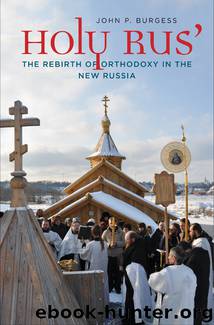Holy Rus': The Rebirth of Orthodoxy in the New Russia by John P. Burgess

Author:John P. Burgess [Burgess, John P.]
Language: eng
Format: epub
Tags: History, Russia & the Former Soviet Union, Religion, Christianity, Orthodox, Christian Church
ISBN: 9780300222241
Google: 5SY2DgAAQBAJ
Amazon: 0300222246
Publisher: Yale University Press
Published: 2017-01-15T00:39:35.439000+00:00
Few Russians will read Mazyrin’s scholarly articles and books, and not all Church historians or leaders agree with Mazyrin that the unmerited suffering of Tikhon and the martyrs is the key to understanding Orthodox identity today. Nevertheless, the Church hierarchy has actively promoted their commemoration and regarded their achievements as significant not only for the Church but also for the nation as a whole.
In December 2012, the Church’s Holy Synod established a commission for “the eternal memorialization of the new martyrs and confessors of the Russian Church” under the direction of Metropolitan Iuvenalii (Poiarkov) of Krutitsa and Kolomna, who had chaired the Church’s canonization commission until 2012. In November 2014, Iuvenalii reported that a growing number of churches and chapels were being dedicated to the new martyrs and confessors. More parishes and dioceses than ever before were celebrating memorial services and processions; erecting commemorative crosses on sites of mass suffering and killing; organizing museums, publications, and educational activities; and identifying candidates for canonization. In some places, government officials had agreed to name public hospitals or streets in honor of local martyrs. The commission had concluded, however, that as of 2013 only 54 out of 147 dioceses had demonstrated satisfactory efforts. Iuvenalii called for intensification of their work prior to the Bishops Council scheduled for 2016.33
During the Soviet era, the Church could not canonize new martyrs. However, already in 1918, the All-Russian Local Council venerated the first of them.34 In 1981, the Russian Orthodox Church Outside of Russia (ROCOR)—composed of Russian émigrés who regarded themselves as the true Russian Church, in contrast to a Moscow Patriarchate compromised by Sergianism (their term for Sergii’s policy of political accommodation)—began canonizing new martyrs in anticipation of the millennium of Christianity in Rus’ in 1988. In 1989, in the wake of glasnost’ and the 1988 millennium celebrations, the Russian Church was able to canonize Patriarch Tikhon, although it could not publicly declare him a new confessor until the collapse of the Soviet Union two years later.
In 1992, the Church canonized seven of the earliest and most prominent new martyrs: Metropolitan Vladimir of Kiev (honored already in 1918 as the first martyred hierarch), Metropolitan Veniamin of Petrograd and three of his associates (falsely charged with withholding Church treasures demanded by the Bolsheviks), and Elizabeth Fedorovna Romanova and her personal attendant Barbara.35 However, not until the Jubilee Council of Bishops in 2000 did commemoration of the new martyrs assume major proportions. On August 19 of that year, the Council of Bishops participated in the consecration of Moscow’s Christ the Savior Cathedral, itself a symbol of the Church’s death and resurrection. Russia’s largest Orthodox church, it was constructed in the nineteenth century as a national memorial to the Russian people’s victory over Napoleon, razed under Stalin, and rebuilt with President Yeltsin’s vigorous support in the 1990s. The altar on the first level of the restored building (the “lower church”) was dedicated to the new martyrs.
On the next day, the council established the Sobor (Council or Congregation) of the
Download
This site does not store any files on its server. We only index and link to content provided by other sites. Please contact the content providers to delete copyright contents if any and email us, we'll remove relevant links or contents immediately.
| Amish | Catholicism |
| Christian Science | Jehovah's Witness |
| Mennonite | Messianic Judaism |
| Mormonism | Orthodoxy |
| Protestantism |
Under the Banner of Heaven: A Story of Violent Faith by Jon Krakauer(1687)
The Early Centuries - Byzantium 01 by John Julius Norwich(1655)
The Amish by Steven M. Nolt(1492)
Taken by J. C. Owens(1486)
In Spirit and Truth (In Spiritu Et Veritate Series) by Reed Zoe(1477)
Play It as It Lays by Joan Didion(1435)
The Apogee - Byzantium 02 by John Julius Norwich(1367)
The Last Man in Russia by Oliver Bullough(1325)
A History of the Amish by Steven M. Nolt(1217)
David Sedaris Diaries by David Sedaris(1167)
Leaving the Witness by Amber Scorah(1156)
Tears of the Silenced: A True Crime and an American Tragedy; Severe Child Abuse and Leaving the Amish by Misty Griffin(1143)
Fallen by unknow(1132)
The Dance of Change by unknow(1097)
The Angel of Forest Hill by Cindy Woodsmall(1082)
The Best of Amish Cooking by Phyllis Pellman Good(1077)
The Ariana Trilogy by Rachel Ann Nunes(1071)
Deep Blue by unknow(1063)
Escape by Carolyn Jessop & Laura Palmer(1055)
